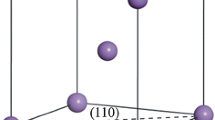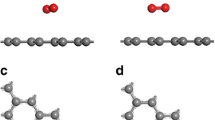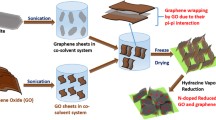Abstract
Graphene-based nanomaterials have attracted great attention for energy storage application in supercapacitors and batteries, along with challenges and perspectives in the exciting field; however, the Li ion batteries with long cycling stability remain a major impediment. In order to enhance the Li+ ion adsorption, we employ density functional theory to investigate the adsorption of Li+ ion with hydrogen-, fluorine-, chlorine- and bromine-terminated pristine sheet and the corresponding Stone–Thrower–Wales and divacancy defect-incorporated graphene sheet. Our results reveal that fluorine termination enhances Li+ ion adsorption compared to H- and other halogen-terminated graphene sheets. On the other hand, Li+ ion adsorption energy is increased on introducing the fluorine termination in both pristine and defected graphene sheets, while Li+ ion adsorption is more in the divacancy-defected graphene. From the density of states analysis, the Fermi level shows 1.9 eV shift toward the valence band for fluorine termination in both pristine and defected graphene sheets. Fluorine termination is shown to have a significant variation in the valence band than the other halogen atoms, and hence, it offers efficient material energy conversion and storage.









Similar content being viewed by others
References
Etacheri V, Marom R, Elazari R, Salitra G, Aurbach D (2011) Challenges in the development of advanced Li-ion batteries: a review. Energy Environ Sci 4:3243–3262. https://doi.org/10.1039/C1EE01598B
Goriparti S, Miele E, De Angelis F, Di Fabrizio E, Zaccaria RP, Capiglia C (2014) Review on recent progress of nanostructured anode materials for Li-ion batteries. J Power Sources 1:421–443. https://doi.org/10.1016/j.jpowsour.2013.11.103
Spyrou K, Rudolf P (2014) An introduction to graphene. Functionalization of graphene. Wiley, pp. 1–20
Geim AK (2009) Graphene: status and prospects. Science 324:1530–1534. https://doi.org/10.1126/science.1158877
Novoselov KS, Geim AK, Morozov S, Jiang D, Katsnelson MI, Grigorieva I, Dubonos S, Firsov AA (2005) Two-dimensional gas of massless Dirac fermions in graphene. Nature 438:197. https://doi.org/10.1038/nature04233
Yoo E, Kim J, Hosono E, Zhou HS, Kudo T, Honma I (2008) Large reversible Li storage of graphene nanosheet families for use in rechargeable lithium ion batteries. Nano Lett 8:2277–2282. https://doi.org/10.1021/nl800957b
Jariwala D, Srivastava A, Ajayan PM (2011) Graphene synthesis and band gap opening. J Nanosci Nanotechnol 11:6621–6641
Xiang Z, Dai Q, Chen JF, Dai L (2016) Edge functionalization of graphene and two-dimensional covalent organic polymers for energy conversion and storage. Adv Mater 28:6253–6261. https://doi.org/10.1002/adma.201505788
Boukhvalov DW, Katsnelson MI (2008) Chemical functionalization of graphene with defects. Nano Lett 8:4373–4379. https://doi.org/10.1021/nl802234n
Elias DC, Nair RR, Mohiuddin TM, Morozov SV, Blake P, Halsall MP, Ferrari AC, Boukhvalov DW, Katsnelson MI, Geim AK, Novoselov KS (2009) Control of graphene’s properties by reversible hydrogenation: evidence for graphane. Science 323:610–613. https://doi.org/10.1126/science.1167130
Ryu S, Han MY, Maultzsch J, Heinz TF, Kim P, Steigerwald ML, Brus LE (2008) Reversible basal plane hydrogenation of graphene. Nano Lett 8:4597–4602. https://doi.org/10.1021/nl802940s
Robinson JT, Burgess JS, Junkermeier CE, Badescu SC, Reinecke TL, Perkins FK, Zalalutdniov MK, Baldwin JW, Culbertson JC, Sheehan PE, Snow ES (2010) Properties of fluorinated graphene films. Nano Lett 10:3001–3005. https://doi.org/10.1021/nl101437p
Zboril R, Karlicky F, Bourlinos AB, Steriotis TA, Stubos AK, Georgakilas V, Safarova K, Jancik D, Trapalis C, Otyepka M (2010) Graphene fluoride: a stable stoichiometric graphene derivative and its chemical conversion to graphene. Small 6:2885–2891. https://doi.org/10.1002/smll.201001401
Deng JP, Chen WH, Chiu SP, Lin CH, Wang BC (2014) Edge-termination and core-modification effects of hexagonal nanosheet graphene. Molecules 19:2361–2373. https://doi.org/10.3390/molecules19022361
Cervantes-Sodi FE, Csanyi G, Piscanec S, Ferrari AC (2008) Edge-functionalized and substitutionally doped graphene nanoribbons: electronic and spin properties. Phys Rev B 77:165427. https://doi.org/10.1103/PhysRevB.77.165427
Nair RR, Ren W, Jalil R, Riaz I, Kravets VG, Britnell L, Blake P, Schedin F, Mayorov AS, Yuan S, Katsnelson MI (2010) Fluorographene: a two-dimensional counterpart of Teflon. Small 6:2877–2884. https://doi.org/10.1002/smll.201001555
Bhattacharya A, Bhattacharya S, Das GP (2011) Strain-induced band-gap deformation of H/F passivated graphene and h-BN sheet. Phys Rev B 84:075454. https://doi.org/10.1103/PhysRevB.84.075454
Klintenberg M, Lebegue S, Katsnelson MI, Eriksson O (2010) Theoretical analysis of the chemical bonding and electronic structure of graphene interacting with Group IA and Group VIIA elements. Phys Rev B 81:085433. https://doi.org/10.1103/PhysRevB.81.085433
Medeiros PV, Mascarenhas AJ, De Brito Mota F, De Castilho CM (2010) A DFT study of halogen atoms adsorbed on graphene layers. Nanotechnology 21:485701. https://doi.org/10.1088/0957-4484/21/48/485701
Tachikawa H, Iyama T (2014) Structures and electronic states of fluorinated graphene. Solid State Sci 28:41–46. https://doi.org/10.1016/j.solidstatesciences.2013.12.014
Zhu C, Yang G (2016) Insights from the adsorption of halide ions on graphene materials. ChemPhysChem 17:2482–2488. https://doi.org/10.1002/cphc.201600271
Zhu C, Yun J, Wang Q, Yang G (2018) Adsorption of ion pairs onto graphene flakes and impacts of counterions during the adsorption processes. Appl Surf Sci 435:329–337. https://doi.org/10.1016/j.apsusc.2017.11.105
Karlicky F, Kumara Ramanatha Datta K, Otyepka M, Zboril R (2013) Halogenated graphenes: rapidly growing family of graphene derivatives. ACS Nano 7:6434–6464. https://doi.org/10.1021/nn4024027
Wehling TO, Katsnelson MI, Lichtenstein AI (2009) Impurities on graphene: midgap states and migration barriers. Phys Rev B 80:085428. https://doi.org/10.1103/PhysRevB.80.085428
Xu J, Jeon IY, Seo JM, Dou S, Dai L, Baek JB (2014) Edge-selectively halogenated graphene nanoplatelets (XGnPs, X = Cl, Br, or I) prepared by ball-milling and used as anode materials for lithium-ion batteries. Adv Mater 26:7317–7323. https://doi.org/10.1002/adma.201402987
Banhart F, Kotakoski J, Krasheninnikov AV (2010) Structural defects in graphene. ACS Nano 5:26–41. https://doi.org/10.1021/nn102598m
Araujo PT, Terrones M, Dresselhaus MS (2012) Defects and impurities in graphene-like materials. Mater Today 15:98–109. https://doi.org/10.1016/S1369-7021(12)70045-7
Liu L, Qing M, Wang Y, Chen S (2015) Defects in graphene: generation, healing, and their effects on the properties of graphene: a review. J Mater Sci Technol 31:599–606. https://doi.org/10.1016/j.jmst.2014.11.019
Anithaa VS, Shankar R, Vijayakumar S (2017) Adsorption of Mn atom on pristine and defected graphene: a density functional theory study. J Mol Model 23:132. https://doi.org/10.1007/s00894-017-3300-5
Anithaa VS, Shankar R, Vijayakumar S (2017) DFT-based investigation on adsorption of methane on pristine and defected graphene. Struct Chem 28:1935–1952. https://doi.org/10.1007/s11224-017-0988-x
Ma J, Alfe D, Michaelides A, Wang E (2009) Stone–Wales defects in graphene and other planar sp2-bonded materials. Phys Rev B 80:033407. https://doi.org/10.1103/PhysRevB.80.033407
Lalitha M, Lakshmipathi S (2017) Gas adsorption efficacy of graphene sheets functionalised with carboxyl, hydroxyl and epoxy groups in conjunction with Stone–Thrower–Wales (STW) and inverse Stone–Thrower–Wales (ISTW) defects. Phys Chem Phys Chem 19:30895–30913. https://doi.org/10.1039/C7CP06900F
Xia J, Liu X, Zhou W, Wang F, Wu H (2016) Transformation between divacancy defects induced by an energy pulse in graphene. Nano Technol 27:274004
Datta D, Li J, Shenoy VB (2014) Defective graphene as a high-capacity anode material for Na-and Ca-ion batteries. ACS Appl Mater Interfaces 6:1788–1795. https://doi.org/10.1021/am404788e
Sangavi S, Santhanamoorthi N, Vijayakumar S (2019) Density functional theory study on the adsorption of alkali metal ions with pristine and defected graphene sheet. Mol Phys 117:462–473. https://doi.org/10.1080/00268976.2018.1523480
Datta D, Li J, Koratkar N, Shenoy VB (2014) Enhanced lithiation in defective graphene. Carbon 80:305–310. https://doi.org/10.1016/j.carbon.2014.08.068
Liang M, Zhi L (2009) Graphene-based electrode materials for rechargeable lithium batteries. J Mater Chem 19:5871–5878. https://doi.org/10.1039/B901551E
Frisch MJ, Trucks GW, Schlegel HB, Scuseria GE, Robb MA, Cheeseman JR, Scalmani G, Barone V, Mennucci B, Petersson G, Nakatsuji H (2009) Gaussian 09, revision a. 02, Gaussian. Inc., Wallingford, CT. 200: 28
Zhao Y, Truhlar DG (2008) The M06 suite of density functionals for main group thermochemistry, thermochemical kinetics, noncovalent interactions, excited states, and transition elements: two new functionals and systematic testing of four M06-class functionals and 12 other functionals. Theor Chem Acc 120:215–241. https://doi.org/10.1007/s00214-007-0401-8
Hay PJ, Wadt WR (1985) Ab initio effective core potentials for molecular calculations: potentials for the transition metal atoms Sc to Hg. J Chem Phys 82(1985):270–283. https://doi.org/10.1063/1.448799
Lu T, Chen F (2012) Multiwfn: a multifunctional wavefunction analyzer. J Comput Chem 33:580–592. https://doi.org/10.1002/jcc.22885
Kumar PS, Raghavendra V, Subramanian V (2016) Bader’s theory of atoms in molecules (AIM) and its applications to chemical bonding. J Chem Sci 128:1527–1536. https://doi.org/10.1007/s12039-016-1172-3
Poater J, Fradera X, Duran M, Sola M (2003) The delocalization index as an electronic aromaticity criterion: application to a series of planar polycyclic aromatic hydrocarbons. Chem - A Eur J 9:400–406. https://doi.org/10.1002/chem.200390041
Matito E, Duran M, Sola M (2005) The aromatic fluctuation index (FLU): A new aromaticity index based on electron delocalization. J Chem Phys 122:014109. https://doi.org/10.1063/1.1824895
Zheng J, Ren Z, Guo P, Fang L, Fan J (2011) Diffusion of Li + ion on graphene: a DFT study. Appl Surf Sci 258:1651–1655. https://doi.org/10.1016/j.apsusc.2011.09.007
Saleh G, Gatti C, Lo Presti L, Contreras-Garcia J (2012) Revealing non-covalent interactions in molecular crystals through their experimental electron densities. Chem A Eur J 18:15523–15536. https://doi.org/10.1002/chem.201201290
Otero-de-la-Roza A, Johnson ER, Contreras-Garcia J (2012) Revealing non-covalent interactions in solids: NCI plots revisited. Phys Chem Chem Phys 14:12165–12172. https://doi.org/10.1039/C2CP41395G
Humphrey W, Dalke A, Schulten K (1996) VMD: visual molecular dynamics. J Mol Grap 14:33–38
Author information
Authors and Affiliations
Corresponding author
Additional information
Publisher's Note
Springer Nature remains neutral with regard to jurisdictional claims in published maps and institutional affiliations.
Electronic supplementary material
Below is the link to the electronic supplementary material.
Rights and permissions
About this article
Cite this article
Shanmugam, S., Nachimuthu, S. & Subramaniam, V. The effect of edge termination on Li+ ion adsorption of pristine and defected graphene sheets. J Mater Sci 55, 5920–5937 (2020). https://doi.org/10.1007/s10853-020-04438-4
Received:
Accepted:
Published:
Issue Date:
DOI: https://doi.org/10.1007/s10853-020-04438-4




